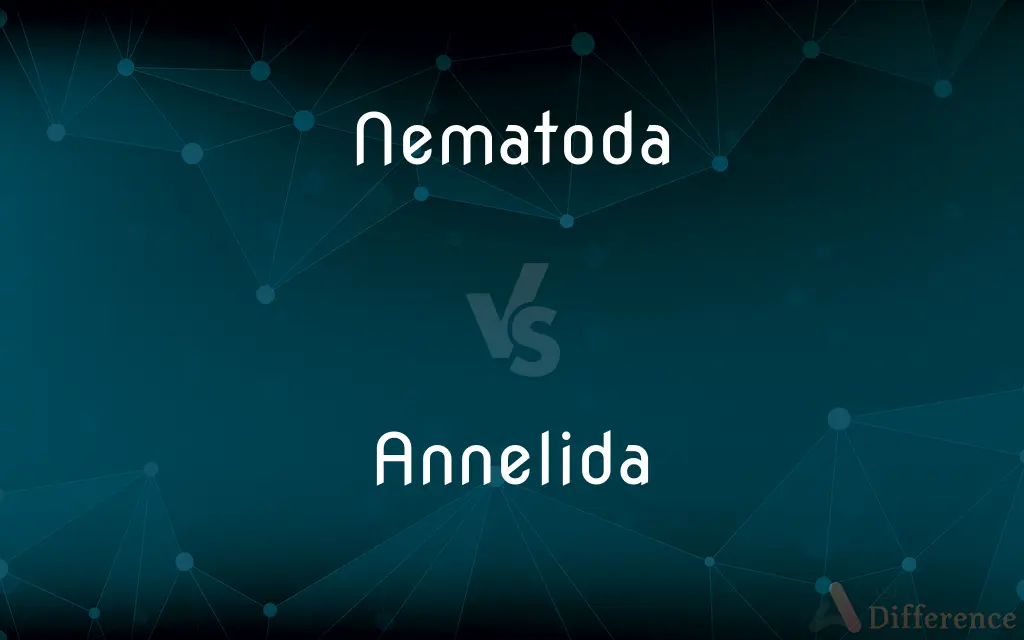Nematoda vs. Annelida — What's the Difference?
By Urooj Arif & Fiza Rafique — Updated on April 15, 2024
Nematoda (roundworms) are unsegmented, cylindrical worms with a pseudocoelom, while Annelida (segmented worms) have true body segmentation and a coelom, exhibiting more complex anatomies.

Difference Between Nematoda and Annelida
Table of Contents
ADVERTISEMENT
Key Differences
Nematoda, or roundworms, possess a simple, unsegmented body structure, which is typically cylindrical and tapered at the ends. In contrast, Annelida, or segmented worms, display a complex segmented body structure, which is divided into multiple ring-like segments, each containing organs and muscle groups.
Nematodes have a body cavity known as a pseudocoelom, which is partially lined with mesoderm, providing a basic structure for their internal organs. On the other hand, annelids have a coelom, a fully lined body cavity that offers greater structural support and allows more complex organ development.
Reproductive strategies in Nematoda typically involve both sexual and asexual methods, with some species capable of significant pathogenic effects on plants and animals. Meanwhile, Annelida usually reproduce sexually, with some capable of regeneration and asexual reproduction, adding to their adaptive capabilities.
The nervous system in Nematoda is relatively simple, consisting mainly of a nerve ring and a dorsal nerve cord. In contrast, Annelida possess a more developed nervous system with a ventral nerve cord and segmented ganglia, enabling more sophisticated responses to environmental stimuli.
Nematodes are found in diverse environments from soil to aquatic habitats and as parasites in plants and animals. Annelids, such as earthworms and leeches, play crucial roles in soil aeration and nutrient cycling, with some species also living in freshwater or marine environments.
ADVERTISEMENT
Comparison Chart
Body Structure
Unsegmented, cylindrical
Segmented, complex body structure
Body Cavity
Pseudocoelom, partially lined
Coelom, fully lined
Reproduction
Sexual and asexual, often pathogenic
Primarily sexual, some asexual and regenerative
Nervous System
Simple, with a nerve ring
More complex, with segmented ganglia
Ecological Roles
Diverse, including parasitic
Soil aeration, nutrient cycling, diverse habitats
Compare with Definitions
Nematoda
Possesses a pseudocoelom.
The pseudocoelom in nematodes provides a basic hydrostatic skeleton.
Annelida
Segmented worms with each segment containing organ systems.
Earthworms’ bodies are divided into numerous segments that help in locomotion.
Nematoda
Includes both microscopic and macroscopic species.
Some soil nematodes are just a few millimeters in length.
Annelida
Important in ecological processes like soil fertility.
Earthworm activity enhances soil quality by aerating it and breaking down organic matter.
Nematoda
Unsegmented worms with a simple cylindrical body.
Nematodes like Caenorhabditis elegans are crucial for scientific research.
Annelida
Have a coelom, providing room for more complex organs.
The coelom in earthworms allows for more efficient digestion and nutrient absorption.
Nematoda
Often parasitic in nature.
Root-knot nematodes damage plant roots, causing significant agricultural losses.
Annelida
Capable of both sexual and asexual reproduction.
Some annelids can regenerate lost segments, facilitating asexual reproduction.
Nematoda
Found in virtually all ecological niches.
Nematodes are present in polar regions, deserts, and tropical rainforests.
Annelida
Includes species like earthworms, polychaetes, and leeches.
Leeches are used medically to stimulate blood circulation in skin grafts.
Nematoda
A phylum of worms, having a long, round, and generally smooth body; the roundworms. They are mostly parasites, in plants and animals, but some are free-living in soil or water. Also called Nematoidea.
Annelida
A division of the Articulata, having the body formed of numerous rings or annular segments, and without jointed legs. The principal subdivisions are the Chætopoda, including the Oligochæta or earthworms and Polychæta or marine worms; and the Hirudinea or leeches. See Chætopoda.
Nematoda
Unsegmented worms: roundworms; threadworms; eelworms
Annelida
Segmented worms: earthworms; lugworms; leeches
Common Curiosities
What distinguishes Nematoda from Annelida anatomically?
Nematoda are unsegmented with a pseudocoelom, whereas Annelida are segmented with a fully lined coelom.
Are all nematodes parasitic?
No, while many nematodes are parasitic, others live freely in soil or aquatic environments.
How do the nervous systems of Nematoda and Annelida compare?
Nematodes have a simpler nervous system, while annelids have a more complex system with segmented ganglia for better environmental interaction.
How do annelids improve agricultural land?
By burrowing and digesting organic material, earthworms improve soil structure and fertility.
How does the body structure of Annelida benefit them?
The segmentation of their body allows for greater mobility and efficiency in their physiological processes.
What are the reproductive differences between Nematoda and Annelida?
Nematoda often reproduce via both sexual and asexual methods, while Annelida primarily engage in sexual reproduction, with some capable of regeneration.
What are common diseases caused by nematodes?
Nematodes can cause diseases like trichinosis and filariasis in humans.
What role do marine annelids play in the ecosystem?
Marine annelids, particularly polychaetes, play key roles in the benthic food web and help in the decomposition of organic materials.
Can Annelida be found in marine environments?
Yes, many annelids, especially polychaetes, are predominant in marine ecosystems.
How do Nematoda and Annelida contribute to the environment?
Nematodes play roles in nutrient cycling and as parasites, while annelids are crucial in soil aeration and decomposition processes.
Are nematodes visible to the naked eye?
Most nematodes are microscopic, but some larger species can be seen without magnification.
Is it possible to control nematode pests?
Yes, nematode pests can be controlled through cultural practices, biological agents, and chemical nematicides.
What is the impact of nematodes on global agriculture?
Nematodes cause billions of dollars in crop losses annually worldwide due to their parasitic nature.
Can Annelida species be used in bioremediation?
Yes, some annelids are used in bioremediation to help clean up polluted soils and waters.
What adaptations help Annelida survive in various habitats?
Annelida have adaptations like bristles and segmented bodies that aid in locomotion and survival in diverse environments.
Share Your Discovery

Previous Comparison
Voucher vs. Invoice
Next Comparison
Focal vs. LocalAuthor Spotlight
Written by
Urooj ArifUrooj is a skilled content writer at Ask Difference, known for her exceptional ability to simplify complex topics into engaging and informative content. With a passion for research and a flair for clear, concise writing, she consistently delivers articles that resonate with our diverse audience.
Co-written by
Fiza RafiqueFiza Rafique is a skilled content writer at AskDifference.com, where she meticulously refines and enhances written pieces. Drawing from her vast editorial expertise, Fiza ensures clarity, accuracy, and precision in every article. Passionate about language, she continually seeks to elevate the quality of content for readers worldwide.
















































